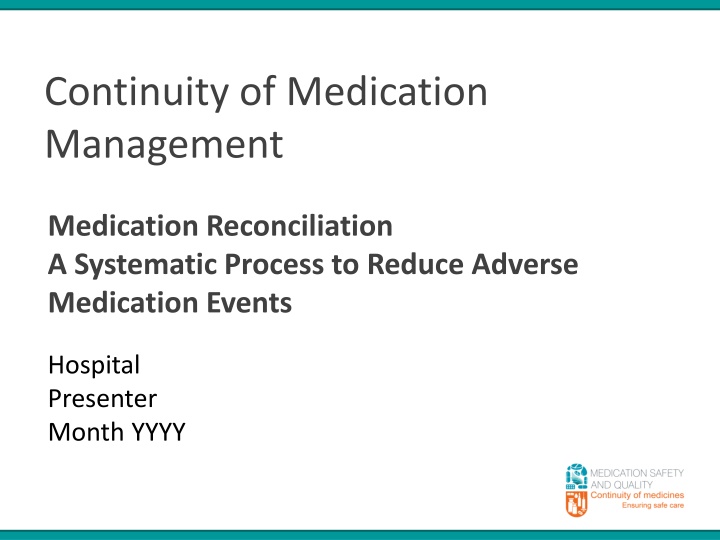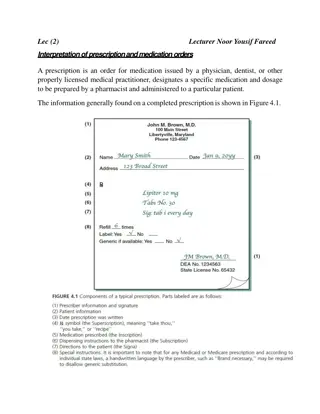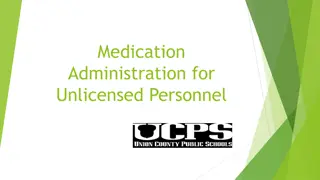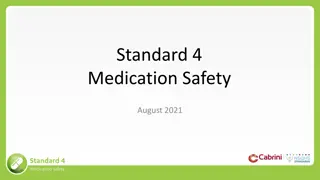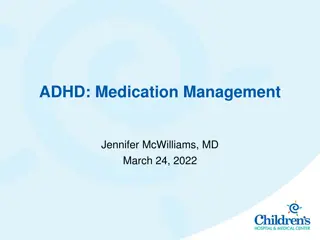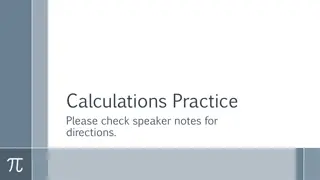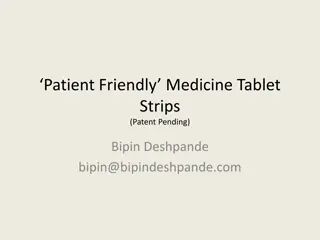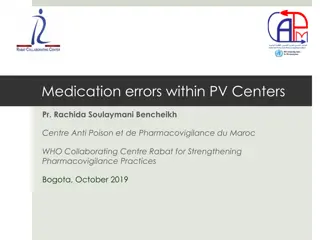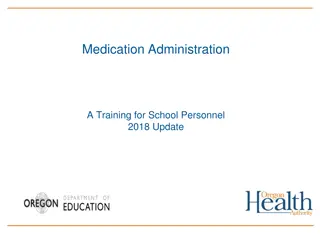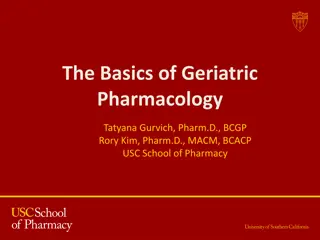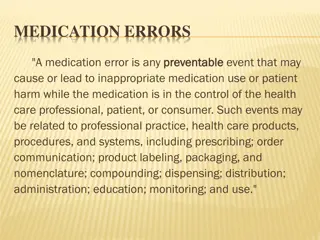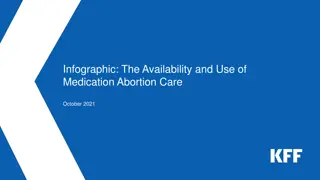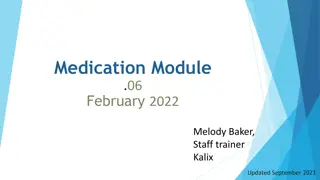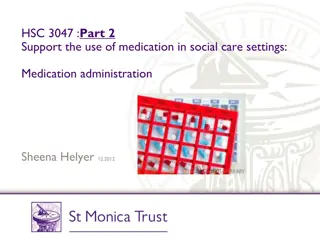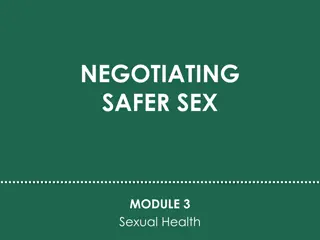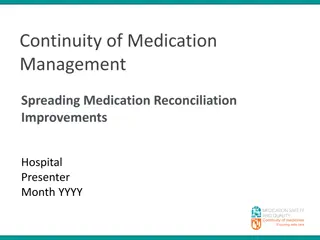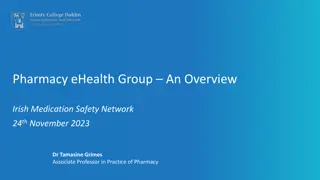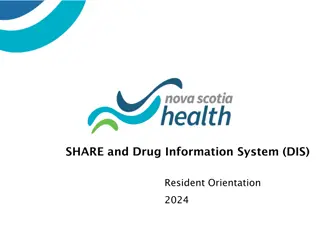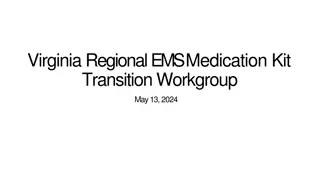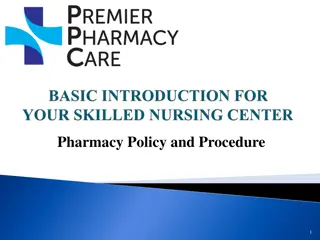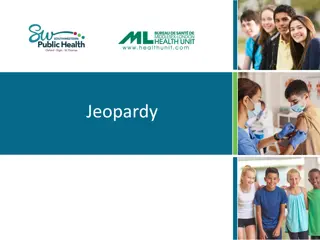Enhancing Medication Management for Safer Healthcare
Medication management continuity is crucial in healthcare to prevent adverse events. Incomplete medication histories, errors in prescribing, and omissions during transitions of care can lead to harmful outcomes. By implementing systematic processes like medication reconciliation, healthcare providers can reduce medication errors, ensure accurate medication information is transferred, and improve patient safety.
Download Presentation

Please find below an Image/Link to download the presentation.
The content on the website is provided AS IS for your information and personal use only. It may not be sold, licensed, or shared on other websites without obtaining consent from the author.If you encounter any issues during the download, it is possible that the publisher has removed the file from their server.
You are allowed to download the files provided on this website for personal or commercial use, subject to the condition that they are used lawfully. All files are the property of their respective owners.
The content on the website is provided AS IS for your information and personal use only. It may not be sold, licensed, or shared on other websites without obtaining consent from the author.
E N D
Presentation Transcript
Continuity of Medication Management Medication Reconciliation A Systematic Process to Reduce Adverse Medication Events Hospital Presenter Month YYYY
Continuity is an Issue in Health Care 10-67% of medication histories contain at least one error1 Incomplete medication histories at the time of admission have been cited as the cause of at least 27% of prescribing errors in hospital2 The most common error is the omission of a regularly used medicine3 Around half of the medication errors that happen in hospital occur on admission or discharge4 30% of these errors have the potential to cause harm3,5
NSW Examples - Medication Errors Aspirin and clopidogrel ceased in ICU and not recommenced when patient transferred to ward Patient suffered sudden cardiac arrest resulting in death May have contributed to patient s death Patient suffered pre- syncopal episode, was transferred to HDU and required noradrenaline Caused temporary harm and required intervention Patient prescribed ramipril 1.25mg daily, medication chart was rewritten as ramipril 12.5mg daily Caused temporary harm and required intervention Patient initiated on new cardiac medication, discharged with no summary or medicine Patient became acutely unwell and was re-admitted
Continuity of Medication Management Continuity of medication management is achieved when a series of medication management cycles, each of which corresponds to an episode of care, is linked so that information is transferred between cycles (APAC 2005)
Medication Management Pathway Procure Decision to prescribe medicine Transfer of verified information Record medicine order/prescription Monitor of response Review of medicine order Patient Administration of medicine Issue of medicine Provision of medicines information Distribution & storage of medicine Quality audit and review
Medication Reconciliation A process to reduce adverse medication events by: - Ensuring patients receive all intended medicines - Mitigating common errors of transcription, omission, commission and duplication - Ensuring accurate, current and comprehensive medication information follows patients on transfer and discharge
Medication Reconciliation 4 Simple Steps to Improve Patient Safety 1. Collect a comprehensive medication history 2. Confirm the accuracy of the history 3. Compare the history with prescribed medicines 4. Supply accurate medicines information
1. What is a Best Possible Medication History (BPMH)? An accurate and complete medication history, or as close as possible Uses at least one other source of medicines information to verify More comprehensive than a routine primary medication history
1. Collect a BPMH Gather an accurate as possible medication history, using a combination of sources of medicines information: - Patient/carer interview when possible AND/OR - Other sources of medicines information e.g. community healthcare provider
2. Confirm the Accuracy of the History Verify the obtained information - Use a secondary source to confirm the interview information OR - Use two or more sources of information to obtain and verify the medication history Explore inconsistencies between the different sources The collecting and confirming steps may occur in succession or concurrently
Sources of Medicines Information Sources may include: - Patient/carer interview (wherever possible) - GP medication list, referral letter, phone call - Patient medication list - Community pharmacy dispensing history - Residential Aged Care Facility (RACF) medication chart - Patient s own medications, prescriptions or dose administration aids - Previous hospital discharge summary
3. Compare the history with prescribed medicines Use the BPMH when determining the medications to be prescribed on admission: - Decide and document the plan for each medicine e.g. to continue, change, withhold or cease - Check the medicines that have been prescribed follow the plan - Compare pre-admission and current medications at every transfer of care
4. Supply Accurate Medicines Information Between wards, hospitals and at discharge consider: - Are all medicines prescribed still relevant? - Do any pre-admission medicines withheld/changed need to be recommenced/changed back? - Are the changes, including reasons clearly documented? - Is the list complete and clear for your patient, your team and the next care provider?
A Tool to Facilitate Medication Reconciliation NSW Medication Management Plan (MMP) Prompts for: - Dose - Frequency - Indication - Duration - Recently ceased - Recently changed - Sources of list - Checklist Area to record medicines taken prior to presentation
Drs Plan column enables comparison with the medication chart at admission Medication Chart MMP
Reconciliation Complete on Admission Tick reconcile column once complete
Identifying and Tracking Issues Area to record: - Identified medication related problems - Action required - Person responsible - Result of action
Assisting Discharge As well as containing a list of the patient s pre-admission medications for comparison at discharge the MMP can: - Capture medication changes during admission - Capture comments e.g. medication administration and supply requirements - Provide a discharge checklist - Identify patients for home medicines review
The National Safety and Quality Health Service Standards 3 criteria linked to medication reconciliation - Criterion 4.6 The clinical workforce taking an accurate medication history - Criterion 4.8 The clinical workforce reviewing the patient s current medication orders and reconciling any discrepancies - Criterion 4.12 Ensuring a current comprehensive list of medicines, and the reason/s for any change, is provided to the receiving clinician and the patient during clinical handovers
National and International The Australian Safety and Quality Goals for Health Care: - Recognise continuity of medication management as an area of priority - Identify care transitions (admission, transfer and discharge) as an area of concern - Define patient populations that are at an increased risk of adverse medication events The World Health Organisation (WHO) names medication reconciliation as one of its High 5 patient safety solutions
Key Points A BPMH results in safer prescribing Documenting a BPMH and plan - Improves communication between the health care team - Reduces error, confusion and re-work - Reduces time and error at discharge Reconciling at admission, ward/hospital transfer and discharge reduces medication errors and patient harm Providing accurate information at transfer/discharge results in safe ongoing care
References 1. Tam V, Knowles SR, Cornish PL, Fine N, Marchesano R, Etchells EE. Frequency, type and clinical importance of medication history errors at admission to hospital: a systematic review. CMAJ 2005;173:510-5. 2. Dobrzanski S, Hammond I, Khan G, Holdsworth H. The nature of hospital prescribing errors. Br J Clin Govern 2002;7:187-93. 3. Cornish PL, Knowles SR, Marchesano R, Tam V, Shadowitz S, Juurlink DN, Etchells EE. Unintended medication discrepancies at the time of hospital admission. Arch Intern Med 2005;165:424-9. 4. Sullivan C, Gleason KM, Rooney D, Groszek JM, Barnard C. Medication reconciliation in the acute care setting: opportunity and challenge for nursing. J Nurs Care Qual 2005;20:95-8. 5. Vira T, Colquhoun M, Etchells EE. Reconcilable differences: correcting medication errors at hospital admission and discharge. Qual Saf Health Care 2006;15:122-6.
